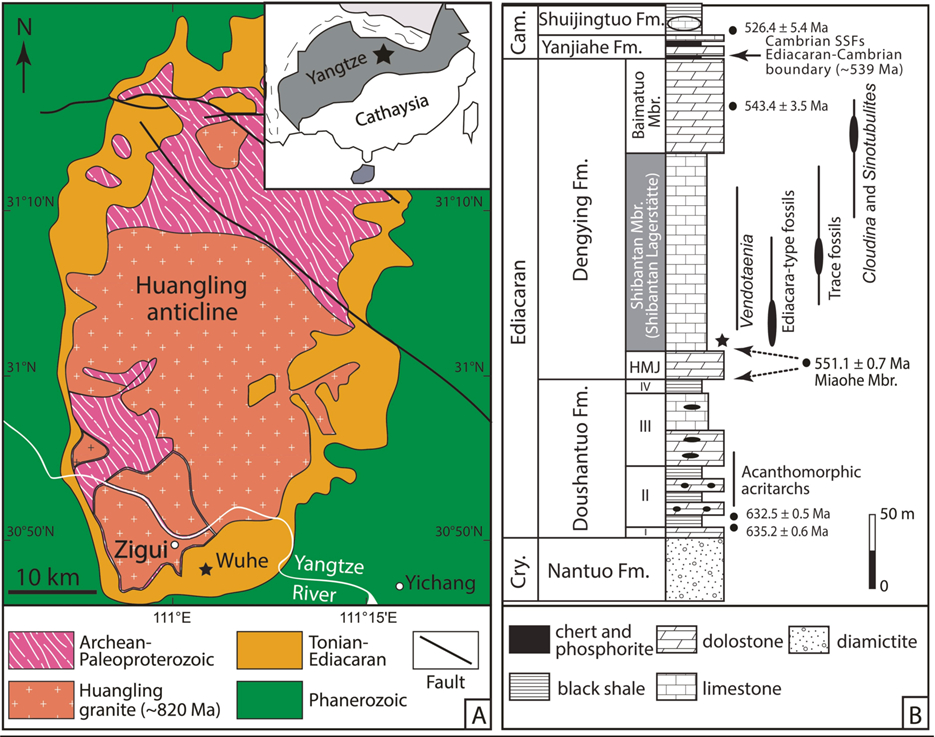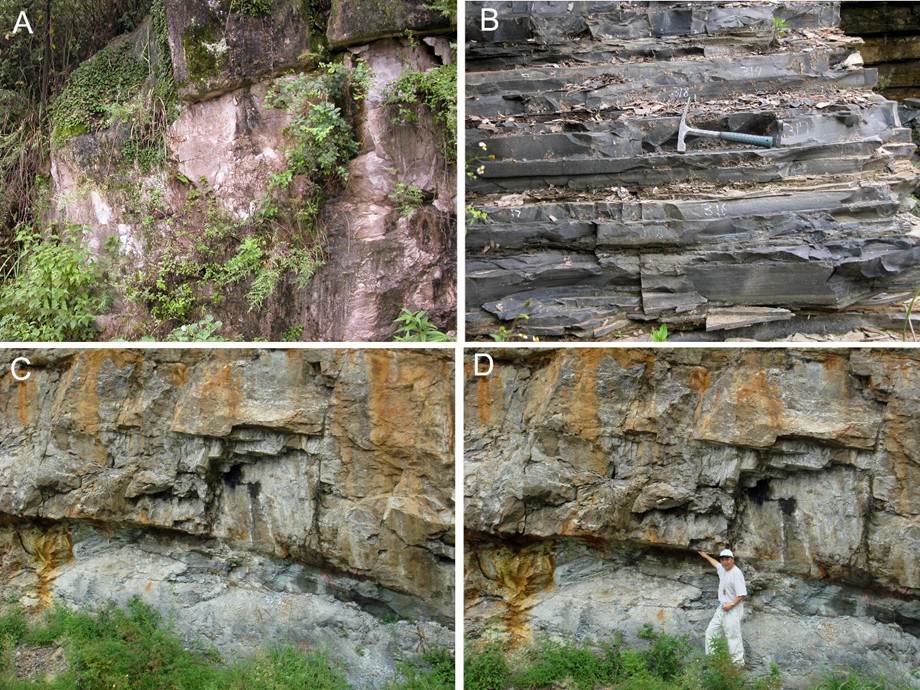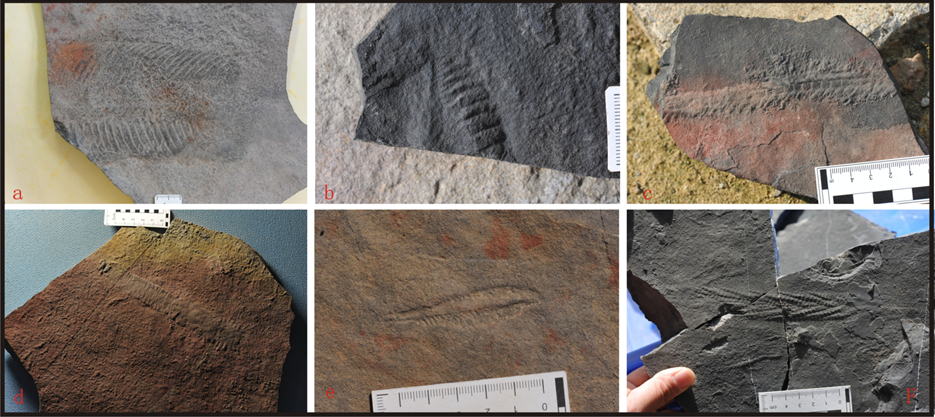Dengying Fm
Type Locality and Naming
It (Tongying or Dengying) Fm was named by Li Siguang (J. S. Lee) and Zhao Yazeng (Y. T. Chao) in 1924. The name is derived from Töngying (spelled Dengying in Hanyu Pinyin) Gorge on the Yangtze (Changjiang) River, near Yichang, western Hubei Province. Originally it was called Töngying Limestone and was renamed Töngying Formation by the Section on Precambrian Geology and Metamorphic Rocks, Chinese Academy of Geological Sciences (1962). The type section is the Dengying Gorge section of Nantuo-Shipai Qingshubao in Yichang County, Hubei Prov (about 2.5 kilometers southeast of Nantuo on the west bank of the Yangtze River), the Three Gorges Stratigraphy Research Group of Hubei Geological Bureau (Zhao Ziqiang et al.), remeasured in 1978. The Qingshubao reference section, measured between Shipai and Nantuo villages on the south bank of the Yangtze (Changjiang) River (111°09’41”E, 30°49’ 42”N), about 20 km northwest of the seat of Yichang City, western Hubei Province, was remeasured by Zhao et al. (1985).
Synonym: (灯影组) , Tongying Fm (old name); Zhoucun Limestone (Jiangxi province ); Yanjingba Dolomite Limestone Fm, Kongmingzhai Limestone Fm, Coal Mountain Fm (Jiangsu province), Hongchunping Fm, Yanjinghe Fm (Sichuan province); Banqiaoshan Section (Fm) (Zhejiang province); Laojunshan Fm, Fanpingdao Fm (Henan province); Baizhaoshan Fm (Hubei province).
Lithology and Thickness
The Dengying Fm is a suite of gray to grayish white carbonate rock, mainly composed of dolomite. Based on lithologic features, it is subdivided into three or four parts: The Lower part, the Hamajing (HMJ) Member, consists of gray-white intraclastic dolomite containing oncolites, cherty bandings and nodules. The Middle part, Shibantan Member, is a thin, black, platy, siliceous bituminous microcrystalline limestone containing flint bands and nodules intercalated with gypsum. The Upper part, the Baimatuo Member, is gray-white medium-thick to massive siliceous dolomite, microcrystalline or coarse recrystalline dolomite, and intraclast dolomite intercalated with cherty beddings, lumps and nodules with syngenetic breccia. An Uppermost dolomite, the Tianzhushan Member, yields small shelly fossils and commonly contains phosphorus, generally forming the phosphorite ore. Its total thickness varies from 200 to 1300 m. In the type section, the formation is 863.42 m thick.
[Figure: The geological section and column modified from Wang et al., 2021]
[Figure: The massive and thick-bedded dolomite and the thin-bedded limestone of Töngying Fm (Dengying Fm), near Yanjiahe, eastern Yangtze Gorge, Yiling District, Yichang, western Hubei Province, South China. A, massive dolomite (Cambrian System) in the upper part of the formation; B, thin-bedded limestone (Cambrian System) in mid-upper part of the of the formation; C, D, Contact relationship between the Töngying Fm (thick-bedded dolomite, Ediacaran System) at the base of the formation and the underlying Doushantuo Fm (black thin-bedded, fine-crystalline dolomite, Ediacaran System). The boundary is pointed by the author, Peng Shanchi; C is close-up view of D.]
Relationships and Distribution
Lower contact
The Dengying Fm rests conformably on the underlying Doushantuo Fm of early through middle Ediacaran.
Upper contact
The uppermost dolomite is bounded with the black shale of the lower Cambrian Shuijingtuo Fm in the type area. It is disconformably overlain by the Niutitang Fm in the type section. However, the formation can be also in conformable with overlying Niurtutang Fm in some other sections
Regional extent
The Töngying Formation is exposed in the Yangtze Area, the Jiangnan Slope and the Jiangbei Slope areas of South China Region, and the northeastern corner of Qiangtang-Simao Region, distributed in eastern Yunnan, Guizhou, Sichuan, Hubei, southern Henan, southern Anhui, southern Jiangsu, northern Jiangxi, northern and western Zhejiang provinces, and Chongqing Municipality. The thickness of the formation varies from place to place. For example, in Hubei Province the thickness varies from 26 to 1812 m; in eastern Yunnan from 129.6 to 1720.4 m; and in northern Jiangxi from only 26 to 80 m.
GeoJSON
Fossils
It yields abundant animal and plant fossils (including nuclear stones, macroalgae, sea gills and small shelly fossils), of which microplants including Micrhystridium, Lophosphaeridium, Pseudozonosphaera, Hubeisphaera etc. (more than 20 genera and 50 species); macroscopic fossil algae including Vendotaenia, Tawuia, Tyrasotaenia etc.; vermes (creeping animals) including Micronemaites, Sinotubulites, Sabellidites etc.; In addition there are sponge-spicules and pennatulids ("sea gills") Paracharnia. Moreover, a large amount of Ediacara fauna has been found in the Shibantan Member (Chen Zhen et al., 2013, 2014, 2018, 2019; Shuhai Xiao et al., 2019). The uppermost phosphatic dolomite or carbonate rock with phosphorite (Tianzhushan Member) has abundant small shelly fossils, which is considered to belong to the age of Lower Cambrian Meishucun stage.
[Figure: Photos of Ediacaran fauna from Chen Zhen: a. Pteridinium, b. Rangea, C. Yilingia, d. Wutubus, e. Arborea, f. Charnia]
Age
Depositional setting
The Dengying Formation belongs to different facies of the carbonate platform, which represents an upward succession from the platform border facies, then to the restricted platform facies of low-energy intertidal zone, finally to the carbonate platform facies. The Dengying Formation overall shows that the sea level was gradually lowering during an interval with characteristics of an arid and hot climate.
Additional Information
The top of Dengying Formation, the Tianzhushan Member, is composed of phosphate dolomite or limestone. It and equivalent horizons in other area yield gastropods, brachiopods, monoplacophoran, hyoliths, etc., and belongs to the Lower Cambrian Meishucun stage. Therefore, the Tianzhushan Member is a transition of the Sinian to Cambrian, or a transition of the Precambrian to Cambrian. A SHRIMP U-Pb data of 549 Ma was measured from the base of the Dengying Formation. (Yin Chongyu et al., 2005).
The upper part of the Töngying Fm in Yunnan has been named Yuhucun Fm (Yuhucun chert-bearing Quartzite) by Wang (1941), Meishucun Fm by Jiang et al. (1964), and Zhujiaqing Fm by Zhu et al. (2001). The former two formations had been abandoned by Zhang (1996), and the last has almost the same concept with either Yuhucun Fm (in narrow sense) or Meishucun Fm and should be also abandoned.


